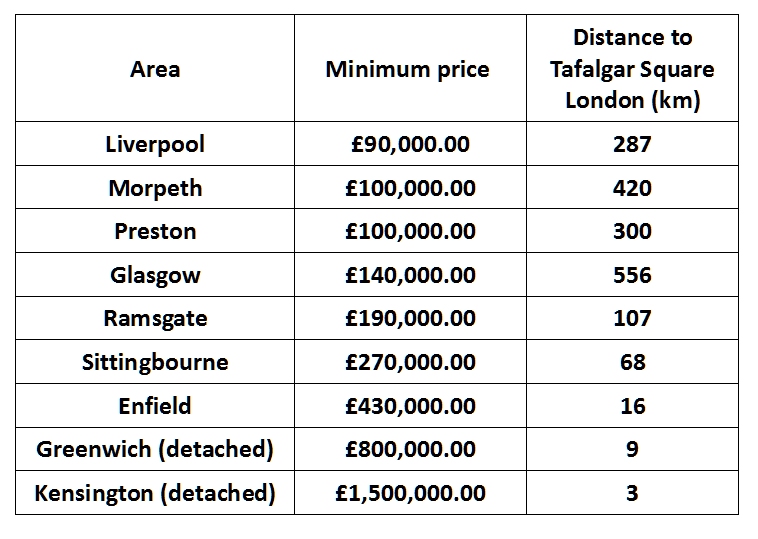Climate, Planning, Economy. Tips 91+
0↓
Contents #91
- #91: Problems with Garden Cities
- #92: The Paris Agreement and the CCC
- #93: Car-free living
- #94: Starter homes for £20K
- #95: Stop the planning racket
- #96: Needed: Green and pleasant jobs
- #97: Fund Lifestyle R&D by planning gain
- #98: Small scale microwave pyrolysis
- #99: Tax income from planning gain
- #100: Raise VAT rates, subsidise jobs
Goto 1 11 21 31 41 51 61 71 81 91 101
↑ #91: Problems with Garden Cities

- Garden Cities and Green Evolutionary Settlements
- Had we but world enough and time
- Developments which failed to be low carbon
- A sustainable prize winner? Goldsmith Street
The Garden Cities Movement, started by Ebeneezer Howard, proposes self-contained communities surrounded by greenbelts, containing areas of residences, industry, and agriculture. The Town and Country Planning Association that he founded continues his work.
Planning for a completely new town or city is a large and complex undertaking: The Letchworth and Welwyn Garden Cities took decades to plan and build. Garden cities were planned as new places to live, built on greenfield sites, planned for a better, pleasanter way of life – with walking as the main means of transport.
There are two problems:
- The time left to reduce our greenhouse gas emissions is short and Garden Cities take decades to plan & build.
- Garden cities are separate “new start” settlements. Concentrating effort on stand alone developments does not help to transform the way most people are living now.
A different approach is to plan green extensions to existing urban settlements, which can infuse sustainability into the old structure. These can be called Green Evolutionary Settlements.
These developments must have very restricted car ownership to be sustainable. This is show by examples of the developments in recent years, which have meant to be “sustainable” but have failed, because they have provided for a large proportion of residents having cars.
↑ #92: The Paris Agreement and the CCC
The CCC is the Committee on Climate Change.
- Cheating with temperature
- Instant Earth & Cumulative Earth.
- The CCC should advise the government that …
The Paris Agreement aimed to curb greenhouse gas emissions so that Earth’s mean surface temperature (GMST) does not rise more than 2°C above pre-industrial temperatures. Even more, it aimed at keeping the rise to 1.5°C . It is an agreement with a target of a maximum temperature, which should not be exceeded in any one year.
What it does not address is the effects of continuous heating over decades, before (and long after) any maximum temperature happens. This heating cumulatively stores heat in the Earth, causing effects like sea level rise and ice sheet collapse. A target of a maximum surface temperature downplays the feedback effects, which accelerate climate change, such as greenhouse emissions from melting permafrost or the change in the way radiation is reflected away from the Earth.
A maximum temperature does not define the state of the Earth: There may be more or less greenhouse heat stored in the ocean. More or less glacier ice may have disappeared. More or less tundra may have thawed. The Paris Agreement does not account for these.
These considerations are relevant to emissions of short lived greenhouse gases, particularly methane. Its effect on surface temperature dissipates after a few decades, due to chemical decomposition. However, most of the greenhouse heat from its stay in the atmosphere is still stored below the Earth’s surface, mostly as ocean heat content, causing sea-level rise and climate feedbacks.
Because the Committee on Climate Change has been given the Paris Agreement as its main goal for climate mitigation, it is restricted in what it can report to UK Government. I argue that this makes it too optimistic and business friendly.
↑ #93: Car-free living and happy degrowth

- Carbon budgets, car free living and happy degrowth
- Car-free cities and pedestrian apartheid
- Car-free estates of wooden prefabs with inbuilt market gardens
- Pedestrian Apartheid – RSPCA News (1976)
People in households with cars have very large carbon footprints. They also live lifestyles that are expensive, not just because of the cost of running a car but also because the way life is organised.
According to a study funded by the European Commission, car-free cities can be two to five times cheaper to live in. Sadly, the study was not translated from the original French and the Commissioner, Carlo Ripa di Meana got the sack.
Minimising the number of cars is a major step in achieving the degrowth that is necessary to prevent dangerous climate change. Green growth is a fantasy because production cannot be decarbonised fast enough to stay within remaining carbon budgets.
RSPCA News was a competition entry I wrote in 1976 about how to live with less cars.
↑ #94: Starter homes for £20K
Starter homes really could be provided for £20K, if the racket in planning permissions could be stopped and modern methods of construction were used. A plot big enough for a house costs £500 at agricultural prices. In York, this becomes about £200,000 when planning permission is granted – planning gain for the land owner. This also pushes up the market value of existing houses.
Wood construction is good because it can be used to make homes made in factories that can be delivered by lorry and can be ecologically sound.
In a comment after Can your children afford to live in York? on YorkMix, Lisa said:
I was very interested in the article by Esther Dent Dodsworth.
I’ve been living in a holiday home, similar to the place her grandma lived in, on a site near York. At first it was just a stopgap but I’ve grown to really like it and here and I’m thinking of staying permanently. There’s nothing more life affirming than waking up surrounded by nature – woods, birds, the occasional deer and falling to sleep to the sound of hooting owls. The space and the fresh air put a bounce in your step!
The people staying here are friendly, everyone always says hello, and the site manager and wardens go out of there way to make sure you’re okay and can always be contacted, even at night which gives the site a sense of community yet it’s easy to maintain your privacy.
The financial benefits are great. The cost of living in a large caravan for the year is £30 per week and the overheads are low as it costs very little to heat a caravan. The static vans, which have two bedrooms and a bathroom, can be bought between £5,000 and £30,000 depending on how new they are. Many families live here all the year round and find it good way of life.
If people want to live cheaply (& pleasantly), why stop them?
↑ #95: Stop the planning racket
- Planning permission is not a natural resource
- Cheap housing, negative equity and crashing the banks
- What would the Bank of England do if new housing were cheap?
- Nonsense on Land Values
- The York Local Plan: Exiling the poor
The York Local Plan: Exiling the poor makes estimates of the planning gain when permission for one house is granted in the York area. The estimates were the best part of £200,000 per house. This value goes to the land owner (or owner of options on the land).
This planning gain is added to the price of new houses. It happens because supply exceeds demand. Existing house owners benefit because scarcity inflates the values of their properties. The result is that the children of the poor will eventually be squeezed out of York.
However, stopping this racket would worry the Bank of England.
What would the Bank of England do if new housing were cheap?
↑ #96: Needed: Green and pleasant jobs

Production is changing:
- Robots can displace many manual jobs.
- Artificial Intelligence can displace “skilled” jobs.
These cause a fall in employment, BUT this can be offset by increased consumption and production. i.e economic growth. How to get enough growth has concerned economists for many decades’
Pleasant jobs
Less need for labour to produce the goods we consume gives the opportunity for hard working workers working less – or working less productively. Many leave high paid jobs to do jobs they like better so pleasantness versus pay is an option and if pay is a measure of productivity, these are less productive. Policies to support the income of the low paid (e.g. Tip #100 below), would support a trend to pleasanter jobs.
Green jobs
The new problem, which limits growth is climate change. More production causes more emissions of greenhouse gases, which are endangering the Earth’s climate. Jobs must also be greener and cause less climate pollution.
Less productive jobs
It is possible to improve production and generate fewer greenhouse gas emissions. The problem is that in recent decades, improvements have not made emissions fall fast enough to avoid a climate disaster.
The remaining option is to reduce production: Less production means fewer greenhouse gas emissions.. (See Oxford Economics 1: Robots and climate.)
If production is reduced, either
- The number of workers in employment falls.
- The average worker must produce less.
… or both.
For high levels of employment,
jobs with low productivity are needed:
Green and pleasant jobs.
(Tip #100: Raise VAT rates, create jobs can help.)
↑ #97: Fund Lifestyle R&D by planning gain
Innovations in engineering can be funded by the protection that patents give. Patents cannot easily be obtained for innovations in town planning.
Planning gain should be used as a mechanism for funding R&D in town planning.
See Paying for research in Energy, waste and sustainable lifestyles.
↑ #98: Small scale microwave pyrolysis
There should be ambitious engineering research and development to deal with municipal waste. One area should be the development of microwave pyrolysis that can work alongside energy from waste incineration that is connected to local heat networks. Pyrolysis can extract raw materials from waste by heating at high temperatures.
Microwave pyrolysis should operate when renewable energy is plentiful. This can be used to pay for the installation of extra renewable energy capacity which can be used when demand for electricity for other purposes is high. There is also the possibility of using pyrolysis products to generate peak time electricity.
A small scale helps with the integration into local heat networks so that heat from pyrolysis can be used.
See Small scale microwave pyrolysis.
↑ #99: Tax income from planning gain.
Much of this is taken from Housing – part 5: Construction and prefabrication.
When planning permission is granted for a house, the plot of land increases in value. In places where demand for housing is high it can be several hundred thousand pounds per plot.
Regional prices for new houses
I looked on Zoopla.co.uk in February 2019 for the price of new build 3 bed semi-detached houses and found these prices, (rounded up to the neatest £10,000).

The cost of building and development does vary a bit throughout the country, but not much. Given the prices above the cost of building a new 3-bed semi cannot be as large as £90,000, let’s assume a figure of £70,000. (Advances in prefabrication will make this much less.)
This means that planning gain per housing plot varies between £20,000 and £360,000, with the places where demand is high, in the £200,000+ range.
Assume that UK Government had a policy of finding green field sites in areas where demand for new housing is high. In these places planning gain would be in the £200,000 range.
If a development tax were applied at a rate of 50%, a million new homes could bring in £100 billion in taxes.
A million homes? That’s just what’s planned for the Oxford Cambridge corridor.
Tip: Tax planning gain.
↑ #100. Raise VAT rates, subsidise jobs.
Note: For “subsidy” read “tax break” – Same meaning different impact.
A scheme to increase nominal VAT rates but to give subsidies for employing people is described in A macroprudential proposal for employment . The original published scheme kept government finances unchanged. Now new tax income may be needed, higher income from VAT may be needed but so is full employment.
How high can VAT rates go?
When income tax is greater than about 70% the revenue generated starts to fall. This may not be the same for expenditure taxes but since VAT is less than 20% now, there is probably a long way to go before tax saturation.
Points about the original scheme
- 1. The VAT rebate scheme (as published) incurs no government spending or borrowing. (HM Treasury conceded this.)
- 2. Although the VAT nominal rate is increased, the total VAT bill falls due to rebates and savings on unemployment.
- 3. Average prices of goods and services should fall, due to lower VAT take.
- 4. It would boost the wages of the lower paid by increased competition for their labour.
OK, it taxes high productivity (i.e. capital intensive goods and goods with high value added per worker). However, since consumption must be cut for environmental reasons, there must be a less productive workforce if full employment is required. This points to slower, pleasanter lifestyles with less demanding jobs.
Let’s not mess with National Insurance as others have suggested. It is a very comforting fiction for the great British public.
Tip: Raise VAT but aim for full employment with VAT rebates.
——-
P.S. Put a bit more cash into Universal Credit.
—–
TrackBack URL :
